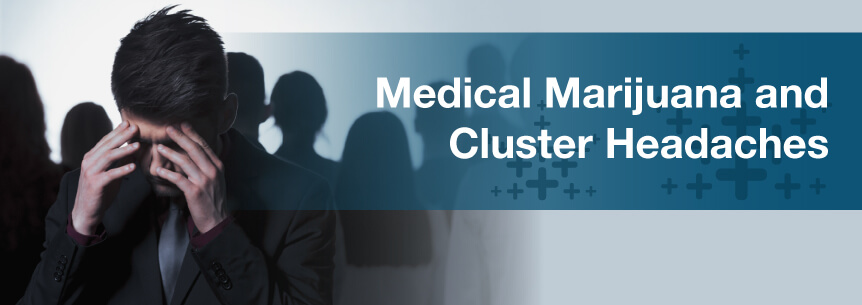
Headache disorders are debilitating, painful — and, sadly, traditional treatments are often inadequate for managing their symptoms. However, some case studies show a potential benefit of medical marijuana for cluster headaches as a treatment option.
Medical marijuana, which is an option for treating cluster headaches, hasn’t been recognized in the U.S. for many years. However, it does have a history of treating headaches. Second millennium BCE Assyrian manuscripts suggested marijuana to “bind the temples.” In the third and fourth centuries BCE, Ayurvedic preparations recommended marijuana for “disease of the head” — referring to migraines.
Find A Doctor Find A Dispensary
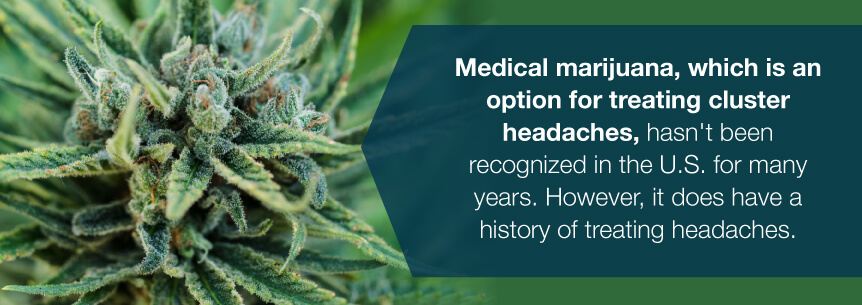
We lack sufficient research regarding medical marijuana for treatment of cluster headaches. However, there is some indication it could help with this condition. The hypothalamus may be, at least in part, responsible for producing cluster headaches.
The hypothalamus has endocannabinoid receptors, to which the active components in medical marijuana attach, causing the wide range of responses medical and recreational marijuana users experience. If medical marijuana can affect change in the areas causing cluster headaches, it may be able to alter the course of cluster headaches, relieve them or even stop them.
A case study published by a group of researchers at the Montefiore Headache Center indicated inhaling medical marijuana could stop cluster headaches. During a headache, the study’s subject would inhale marijuana and experience cessation of the headache within minutes of administration. Furthermore, the subject experienced identical results after receiving a dose of synthetic THC in the form of dronabinol.
This patient experienced results with medical marijuana, despite having had no relief from typical cluster headache medications. If continued research shows similar results in other cluster headache sufferers, this could be a tremendous breakthrough for these unfortunate individuals, particularly those who do not respond to traditional treatment. More research is required to determine whether other synthetic marijuana medications will produce the same results.
On its own, the study described above is not sufficient to determine whether medical marijuana will help a significant portion of cluster headache sufferers, since it only involved a single participant. However, the treatment of a similar type of a headache — a migraine — with medical marijuana has been more extensively studied and has produced promising results.
Medical cannabis for cluster headaches can effectively treat:
As a pain reliever, marijuana is very mild. It does not have even close to the same effect as opiates. However, it is safe in that it cannot produce overdose or death. It also has much more potential in other departments, apart from pain relief.
In many conditions — such as glaucoma — it’s quite likely marijuana can attack the root of the problem, not just the symptoms. Researchers think this will be the case with the successful treatment of cluster headaches with medical marijuana as well. In the study cited above, the patient reported almost immediate cessation of excruciating pain, despite marijuana only having mild pain-relieving effects. These results seem to indicate marijuana can treat the cause of the pain, not just the pain itself.
Secondary effects marijuana treats for cluster headaches are:
Those who suffer from cluster headaches dread their next headache. They may need to ask for help to complete basic tasks or adjust their physical activities. Some don’t make plans out of fear a headache will strike, which leads to social isolation.
A patient’s whole world seems to shatter when a cluster headache starts. Their headache pain can be debilitating. For extreme pain from your headaches, some strains you may wish to try include:
When the pain of your cluster headaches starts to attack, you’ll wish you had any one of these marijuana and cluster headaches strains at hand.
Some patients experience beneficial effects by smoking medical weed. But, for other people, smoking it seems to trigger their cluster headaches. When having an attack, don’t smoke your cannabis, since it could amplify the attack.
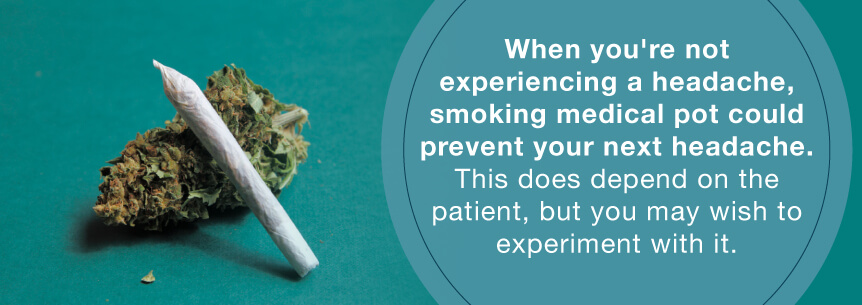
However, when you’re not experiencing a headache, smoking medical pot could prevent your next headache. This does depend on the patient, but you may wish to experiment with it.
Not everybody likes to smoke the herb, however. Therefore, for those patients who prefer not to smoke it, there are other smoke-free alternatives to use medical cannabis you can try. These include:
Now you know some of the methods of consumption and strains available, it’s time to purchase the products you’ll need to alleviate your cluster headaches. But first, you’ll need to search for a medical marijuana doctor to get a recommendation for cannabis.
With so many options available to you for finding your marijuana for cluster headaches treatment, you’ll want to know you’re in good hands. You can use MarijuanaDoctors.com to find a medical cannabis dispensary or doctor all in the same place.
Find A Doctor Find A Dispensary
Cluster headaches are a rare, primary headache disorder. They occur when you have severe headaches occurring on one side of your head, typically accompanied by:
A cluster headache gets its name due to the recurrence of headache attacks, generally in cluster periods or in a series lasting for weeks or even months. Remission follows these periods where you don’t have a headache for months or even years.
Cluster headaches aren’t common and usually affect around one to two in every 1,000 individuals. Most of these individuals smoke. Because of hormonal influences, women experience these headaches more than men in a ratio of approximately two to one, according to the World Health Organization. However, the American Migraine Foundation has conflicting reports saying men are more likely to get cluster headaches than women in a three-to-one ratio.
People have reported cluster headaches as the most painful type of headache they have experienced. Individuals describe them as:
Sufferers have equated the pain of a cluster headache to sticking a hot poker in their eye. Some moms say they are more painful than giving birth. People also refer to them as “suicide headaches,” since the pain can get so intense, it’s caused some people to take their own lives.
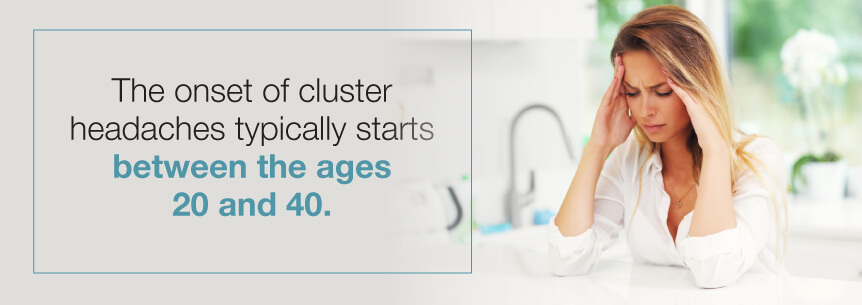
The onset of cluster headaches typically starts between the ages 20 and 40.
Physicians aren’t entirely sure what causes cluster headaches. However, they hypothesize the headaches are related to the sudden histamine release of the body. Histamine is a chemical the body releases when going through an allergic response. A sudden serotonin release may also cause them. Either way, doctors believe the hypothalamus — a small area at the base of the brain — plays a role.
Cluster headaches tend to run in families, and may have triggers such as:
A common trigger for these types of headaches is the season, with headaches occurring more in the spring and autumn seasons. Doctors frequently link cluster headaches with sinusitis or allergies by mistake, due to their seasonal nature. Cluster headaches developing during the seasons are most likely due to activation or stimulation of the hypothalamus.
While going through a cluster period, the patient is more sensitive to the action of nicotine and alcohol, and even a small amount of alcohol could be a trigger for these headaches. However, when the patient isn’t going through a cluster period or is in remission, they can drink alcohol without triggering a headache. Smoking may also make cluster headaches worse when the patient is in the middle of a cluster period.
There are two cluster headache types.
1) Episodic cluster headaches: These are more common. Patients who are suffering from episodic cluster headaches tend to have one to three cluster periods where they are susceptible to the onset of headaches. They then have a six-month-or-more remission period where they’re free of the headaches. Approximately 90 percent of individuals who have these headaches have episodic cluster headaches.
2) Chronic cluster headaches: These headaches occur in patients for at least 12 months without remission. Around 10 percent of individuals suffering from cluster headaches have this type.
Dutch physician Nicolaes Tulp published the first concise explanations of cluster headaches in 1641. About a dozen different names for a cluster headache have surfaced, including “erythroprosopalgia of Bing” and “sphenopalatine neuralgia.”
American physician E. Charles Kunkle gave cluster headaches their name in 1952, when he noticed they “cluster” together. Doctors categorized these types of headaches as a variant of migraines until recently, when the first International Classification of Headache Disorders established cluster headaches as a separate disorder in 1998.
Cluster headaches typically start abruptly. Some people experience flashes of light or other aura-like visual disturbances before they get a headache. The headache may even start a couple of hours after you’ve fallen asleep and will often wake you up because they’re so painful.
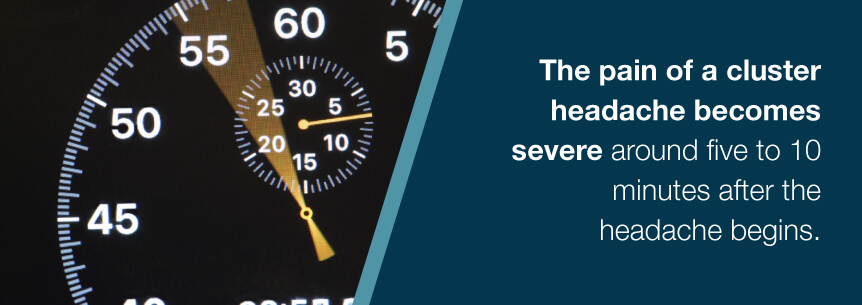
The pain of a cluster headache becomes severe around five to 10 minutes after the headache begins. The headaches tend to last for a few hours, with intense pain lasting anywhere from a half hour to a couple of hours.
You typically get a cluster headache on only one side of your head, but it could switch sides. These headaches present pain around or behind the eye. Patients describe them as deep burning, constant and piercing pain. The pain can spread to your:
You may experience other symptoms on the side of your head where you’re experiencing the pain, such as:
Nausea and vomiting don’t usually accompany cluster headaches. Those with these headaches seem to have the same light and sound sensitivity as those with migraines. It’s possible you can also suffer from migraines when you have cluster headaches.
Those struggling with cluster headaches, particularly those with cheek or tooth pain during their cluster attacks, are at a higher risk of getting a stomach ulcer.
Your cluster headache symptoms may appear like other medical conditions or problems. Therefore, it’s essential you see your physician for an accurate diagnosis.
Cluster headaches don’t cause permanent brain damage and aren’t life-threatening. However, they are recurrent, chronic and can interfere with work or your lifestyle. They’re typically a lifelong issue with potential outcomes including:
With the extreme pain cluster headache patients endure, it’s no wonder many also struggle with anxiety and depression.
A recent study shows those suffering from cluster headaches tend to experience an increase in mood disturbances, memory problems and a poorer quality of life than individuals who don’t have this disorder. Thirty-three people participated in this study: 11 of them with chronic cluster headache, 11 with episodic cluster headache and 11 controls.
Around a third of the participants with a chronic and episodic headache struggled with depression. Seventy-five percent with chronic cluster headache also struggled with anxiety when compared to the 38 percent with episodic cluster headache. Both groups reported high levels of disability.
The National Center for Biotechnology Information reported the following information about cluster headaches:
OTC pain medication like ibuprofen or aspirin is not effective for many cluster headache sufferers, since the pain begins and ends so quickly the headache is practically gone by the time the medication kicks in.
When it comes to cluster headaches, doctors recommend fast treatment, since the patients have severe pain. Nasal sprays and injectables work far faster than pills, but to treat a cluster headache the fastest, doctors give the patient a mask blowing high-flow oxygen for several minutes or so.
Pain medicine relieves the pain of your headache the minute it starts. Treatments include:
Some new treatment options that are still under consideration include:
Researchers are considering hypothalamus-targeted treatments to be the most effective at treating cluster headaches. The most attractive option is deep brain stimulation if you aren’t responding to other treatments.
You should take prevention medicines every day to keep headaches away. These include:
Other preventive methods for cluster headaches are a short course of steroids or a daily dose of verapamil.
To receive a diagnosis of cluster headaches, your doctor will inquire about your symptoms and give you a neurological and physical exam, which could include a CT scan or MRI of your brain to see if there are any brain tumors or other causes of your headaches.